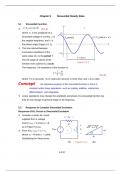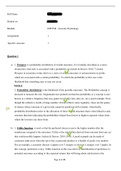Article 1: The role of inhibition in exposure therapy
Emotional Processing Theory (EPT)
Emphasizes fear habituation as one of the primary underlying processes of
successful exposure therapy. This theory is only weakly supported.
More recent theories of exposure therapy highlight the importance of inhibitory
regulation (information of safety learning) as the primary underlying mechanism
of successful exposure therapy.
So, instead of weakening the original fear (which is the assumption of EPT), it is
now believed that the establishment of new memories that effectively compete
with the original fear, is central to fear extinction.
Although traditional exposure therapies often are successful, still a number of
patients fail to achieve clinically significant symptom relief. This fact may derive
in part from deficits in this inhibitory learning and regulation. This means that
there is clinically value for optimizing inhibitory learning and regulation during
exposure therapy.
There are a number of methods for optimizing this:
1. Enhancing inhibitory learning
2. Enhancing inhibitory regulation
3. Weakening fear memories
4. Enhancing retrieval of inhibitory learning
Learning based models of exposure therapy a historical overview
Systematic desensitization
Exposure was first used in the therapy form of systematic desensitization.
Wolpe introduced the mechanism behind this therapy: counterconditioning (or:
reciprocal inhibition). This mechanism was a combination of:
Pavlovian extinction (repeated exposure to the CS in absence of the
UCS)
Hullian Drive Theory (anxiety is a drive that motivates behaviour)
The procedure consisted of a response antagonistic to anxiety (for instance: to
food) occurred in the presence of the anxiety provoking stimulus. This way, the
bond between the stimulus (CS) and the anxiety (CR) weakened. Practically, this
means that the anxiety during therapy was increased through gradual in vitro
(imaginal) exposure, while the patient utilizes relaxation. It was thought to be
essential that the anxiety of the patient remained weak during the exposure, of
at least weaker than the relaxation response.
Two developments challenged this reciprocal inhibition:
1. Research showed that gradual exposure was equally effective with or without
relaxation. This challenged the premises that relaxation was a crucial component
of exposure therapy.
2. Flooding therapy seemed to be equally effective (prolonged an continuous
exposure to highly anxiety provoking stimuli, until the fear declines). This
challenged the premises that the anxiety had to stay at low levels during
exposure.
Habituation
Habituation provided the framework for systematic desensitization and in vivo
(real life) exposure. Habituation replaced the reciprocal model of inhibition
(relaxation instead of fear). But: habituation was viewed as a transient process,
so it couldn’t account for the long lasting fear reductions through exposure.
Emotional processing theory
, Emphasized habituation as a precursor to cognitive correction. Cognitive
correction involved:
Activation of a fear structure
Integration of information that is incompatible with this fear structure
This incompatible information came first from within-session exposures, and later
during therapy from without-sessions exposures. The latter resulted in long-term
learning. Treatment success depended on the fact that anxiety levels during the
first treatment session were elevated, that reductions took place by the within
and between session exposures.
But the support for EPT was inconsistent, suggesting that the amount by which
fear habituates from the beginning to the end is not a good predictor of overall
outcomes.
Still, almost 50% of patients remain symptomatic after exposure, why??
There is a need for finding strategies that can optimize exposure therapy.
The inhibition model of extinction
It is now thought that inhibitory learning is central to extinction. But: additional
mechanisms such as habituation also play a small role. The inhibition model of
extinction proposes that the CS-UCS association is NOT erased during extinction,
but instead left intact while a new, secondary inhibitory learning develops about
the CS-UCS association. This new association is context dependent, while the old
(excitatory) association is context independent. This way, the context can be
seen as an occasion setter for the inhibitory association, for instance: as a
retrieval cue for the extinction memory.
After the extinction process, the CS possesses two meanings:
1. The original excitatory meaning (CS means UCS)
2. The new inhibitory meaning (CS no UCS)
This means that the new association can be uncovered again easily:
By spontaneous recovery
After an interval of time without practice, the strength of the CR increases
again (the new association is weakened because it is practiced too little)
By renewal
If the surrounding context is changed between extinction and retest (the
fear extinction is specific to the context. When the old association retains
their value in a new context, the association (CS=UCS)can also be renewed
in the original context). This means that the context is not a safety signal
anymore. This happens when the exposure is completed in a limited
number of contexts.
By reinstatement
When the UCS presentation occurs in between extinction and retest (for
example: a new car accident). This is a context dependent phenomenon.
The effect depends on the fearfulness of the context in which the CS is
retested. The context-UCS association retrieves the extinguished fear from
memory. Especially when the CS retains negative valence following
extinction.
By reacquisition
When the CS-UCS pairings are repeated after extinction, ruling over the
new inhibitory learning.
Neurobiology of fear extinction
The amygdala plays a primary role in fear conditioning. Other regions that
are associated with fear conditioning are the hippocampus, insular cortex
and the dorsal & rostral ACC. The vmPFC is believed to mediate extinction,











